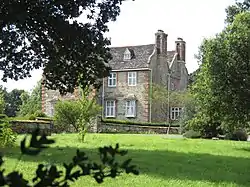| Newbuildings Place | |
|---|---|
 Newbuildings Place in 2016 | |
| General information | |
| Status | Completed |
| Type | House |
| Architectural style | Artisan Mannerism |
| Classification | Grade I |
| Location | Shipley, West Sussex |
| Coordinates | 51°0′30″N 0°22′32″W / 51.00833°N 0.37556°W |
| Completed | c. 1683 |
| Owner | John Lytton, 5th Earl of Lytton |
| Technical details | |
| Material | Stone |
Newbuildings Place is a 17th-century Artisan Mannerist house near Shipley, West Sussex. The house is a former home of Wilfrid Scawen Blunt, who is buried in the grounds of the house. The building is currently owned by John Lytton, 5th Earl of Lytton, and is Grade I listed.
History

Newbuildings Place was built by Philip Caryll in the 17th century, around 1683. Caryll's family owned the estate for over 100 years.[1] The house was built with numerous priest holes, as the Caryll family were Roman Catholic.[1] It is situated around 1.5 miles (2.4 km) from the church in Shipley, West Sussex.[2]
In the 1820s and 1830s, paupers were housed at Newbuildings Place.[3] In 1833, some of the paupers damaged the house by using its wood panelling for firewood.[4] The building is a former home of Wilfrid Scawen Blunt,[5] an author, poet and Arabian horse breeder.[1] Blunt originally lived in the house from 1870 to 1872, during which time he added oak to the house's porch and panelling.[3] He moved back into Newbuildings Place in 1906, after his separation from Lady Anne Blunt.[6] Whilst living there, he bought tapestries and furniture from William Morris, which still survive in the house.[1] Blunt is buried in a tomb in the house's grounds;[6] in his will, he requested to be buried in the house's woods in his travelling carpet rather than in a coffin.[7][8]
Blunt's daughter, who inherited the house, was married to Neville Bulwer-Lytton, 3rd Earl of Lytton.[9] In 1957, the house was sold to Judith Blunt-Lytton, 16th Baroness Wentworth, and after being owned by some of her relatives, it was then owned by John Lytton, 5th Earl of Lytton.[3] In 1959, the house became a Grade I listed building.[1] The grounds of the house contain a Grade II listed barn,[10] and a Grade II listed dovecote.[11]
Architecture
Newbuildings Place is built in the Artisan Mannerist style, with some interior features matching the Jacobean style.[2] The style of the building is unusual for houses in Sussex, whereas it is more common in Kent and Surrey.[2] The house is built of stone, including Horsham Stone, and has two storeys.[1] The kitchen and cellar are original to the house.[1] The façades of the house contain two gables.[3][2] The roof of the building is made of Horsham stone slab.[1]
References
- 1 2 3 4 5 6 7 8 Historic England. "Newbuildings Place (1180744)". National Heritage List for England.
- 1 2 3 4 Nairn, Ian; Pevsner, Nikolaus (2001). Sussex. Yale University Press. p. 323. ISBN 9780300096774.
- 1 2 3 4 A History of the County of Sussex: Volume 6 Part 2, Bramber Rape (North-Western Part) Including Horsham. Vol. 6. Victoria County History. 1986. pp. 112–117 – via British History Online.
- ↑ "Horsham, Sussex". Workhouses. Retrieved 14 July 2021.
- ↑ "Shipley" (PDF). Horsham District. June 2012. p. 11. Retrieved 14 July 2021.
- 1 2 "Report On The History Of Crawley Parks" (PDF). Sussex Gardens Trust. March 2013. pp. 17–19. Retrieved 14 July 2021.
- ↑ "Mr Wilfred S. Blunt's Will". The Guardian. 12 February 1923. p. 11. Retrieved 15 July 2021 – via Newspapers.com.
- ↑ "Rich Briton evens vetoes a coffin". The Beatrice Daily Express. 13 March 1923. p. 1. Retrieved 14 July 2021 – via Newspapers.com.
- ↑ "Sussex Depicted" (PDF). Sussex Record Society. 2001. p. 259. Retrieved 15 July 2021.
- ↑ Historic England. "Barn to South East of Newbuildings Place (1026929)". National Heritage List for England.
- ↑ Historic England. "Dovecot to South of Newbuildings Place (1354236)". National Heritage List for England.